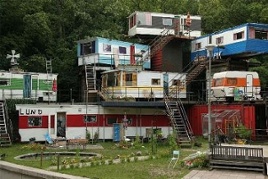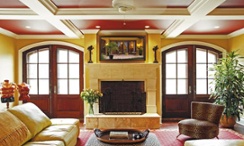Green Modular Homes Defy Stereotypes

 What pops into your mind when you hear the term ‘modular home’? Cheap? Flimsy? Ugly? Trailer? Energy hog? Boxy? Cramped? Well, let me try to bring you up to speed in the field of modular, and especially green modular homes.
What pops into your mind when you hear the term ‘modular home’? Cheap? Flimsy? Ugly? Trailer? Energy hog? Boxy? Cramped? Well, let me try to bring you up to speed in the field of modular, and especially green modular homes.
What pops into your mind when you hear the term ‘modular home’? Cheap? Flimsy? Ugly? Trailer? Energy hog? Boxy? Cramped? Well, let me try to bring you up to speed in the field of modular, and especially green modular homes.
The takeaway here is the same as in the article Chris wrote yesterday, Does a High Performance Home Have to Look Weird? Things ain’t always what they seem to be. You’d have to be an expert in modular homes to tell that the homes shown below, for example, were built in a factory.
T he point Chris made yesterday is that high performance homes don’t have to look any different than the conventional homes around them. It’s the stuff behind the walls that makes the difference. Modular homes are the same. Although there are certainly cheap, boxy modular homes that are energy hogs, it’s also possible to make beautiful, traditional, and even green modular homes, as you can see from the photos on this page (except for that first one).
he point Chris made yesterday is that high performance homes don’t have to look any different than the conventional homes around them. It’s the stuff behind the walls that makes the difference. Modular homes are the same. Although there are certainly cheap, boxy modular homes that are energy hogs, it’s also possible to make beautiful, traditional, and even green modular homes, as you can see from the photos on this page (except for that first one).
On the green front, for the past three years I’ve been working with Haven Custom Homes, a modular builder whose main business until r ecently had been high end custom homes, mostly in places like Long Island, Connecticut, and Cape Cod.
ecently had been high end custom homes, mostly in places like Long Island, Connecticut, and Cape Cod.
When I started working with them in 2007, they’d recently opened a new plant not far from Hilton Head in South Carolina, and I was the regional manager for the EarthCraft House green building program. They’d decided they were ready to go green, and their research pointed them to the EarthCraft program since their SC plant was focused on building modular homes for the Southeast.
I helped them with private trainings for their plant workers and project managers, in the SC plant, the PA facilities, and at their corporate headquarters in Baltimore. They held a design review with about 20 people involved in various capacities for their first green project, the Hunley Waters development in North Charleston. They even sent two of their guys to the week-long home energy rater class.
Haven Custom Homes has really embraced green building and has put in the effort to make sure they achieve their goals. Th ey’ve been very methodical about adopting green building methods and now use it as their baseline. Not every home that leaves their plant gets the ENERGY STAR label or certification in a green building program like EarthCraft House, LEED for Homes, or the NAHB’s Green Building Program. But they all leave the plant with that capability.
ey’ve been very methodical about adopting green building methods and now use it as their baseline. Not every home that leaves their plant gets the ENERGY STAR label or certification in a green building program like EarthCraft House, LEED for Homes, or the NAHB’s Green Building Program. But they all leave the plant with that capability.
With modular homes, two builders are involved. Haven builds the house in the plant as a group of boxes. They take each box as far as they can, installing drywall, wiring, plumbing, roofing, and cabinets. When the boxes are ready, Haven takes them to the job site and sets them on the foundation. It takes a few days to button everything up and finish their part, at which point the home is 70 to 85 percent complete.
 The finish builder then takes over, and the home can go from foundation to certificate of occupancy in less than 30 days. If the client chooses not to pursue green building certification or the ENERGY STAR homes program, the finish builder doesn’t bother with meeting program guidelines. Still, the home will be better than a conventional home because Haven took it two-thirds of the way.
The finish builder then takes over, and the home can go from foundation to certificate of occupancy in less than 30 days. If the client chooses not to pursue green building certification or the ENERGY STAR homes program, the finish builder doesn’t bother with meeting program guidelines. Still, the home will be better than a conventional home because Haven took it two-thirds of the way.
Here’s a list of some of the advantages of the modular home process:
- Materials and partially constructed homes not exposed to the weather
- Better quality control
- Construction waste minimized
- House finished quickly
- Less opportunity for theft and vandalism
I’ll write more about the green modular homes manufacturing process in a future article. Some of the details may surprise you.
This Post Has 4 Comments
Comments are closed.

I’m looking forward to more
I’m looking forward to more details in a latr ost!
And perhaps an answer to a question or two:
I wonder what role architects play in constructing and setting up factory built houses on site. Who makes sure the house will not require alteration to fit local codes? EKL
EKL, architects aren’t
EKL, architects aren’t involved in the actual set, where the house gets assembled on the foundation. Haven has a crew of designers, engineers, and technicians, though, that make sure that each house they build complies with all the local codes. A house going to the coast, for example, has to meet all the codes for hurricane resistance, and Haven’s very good about ensuring that they know the codes that apply in each client’s location.
We have built our 1930
We have built our 1930 Craftsman style modular that is Energy Star as well as “Net Zero” after 9 months of homeowner living.
I would like to see plans and
I would like to see plans and prices for your homes. Planning on retiring in three or four years.